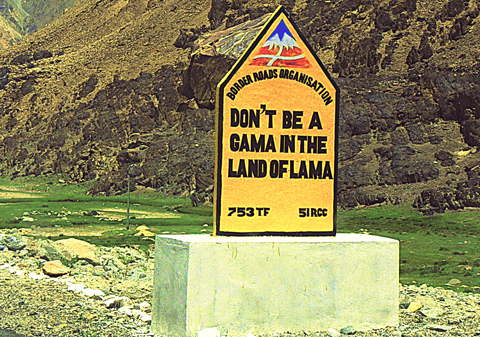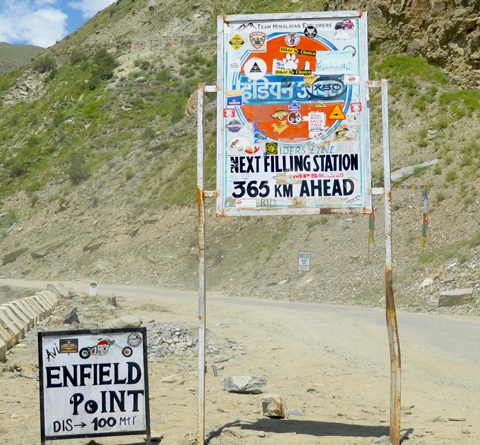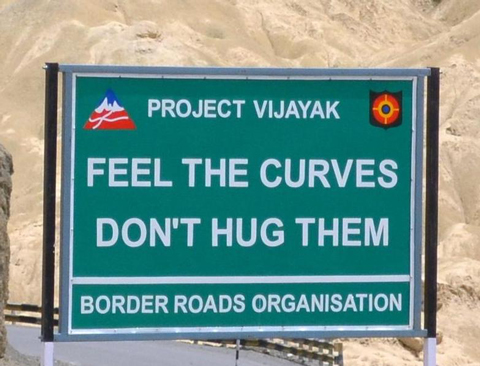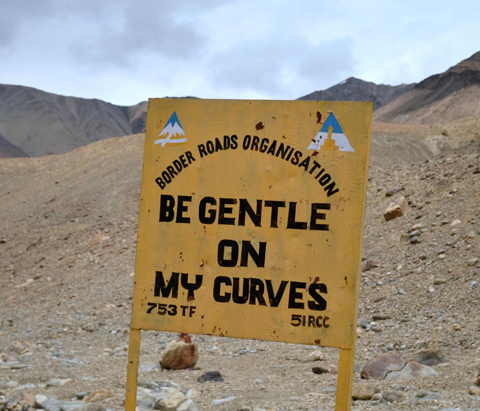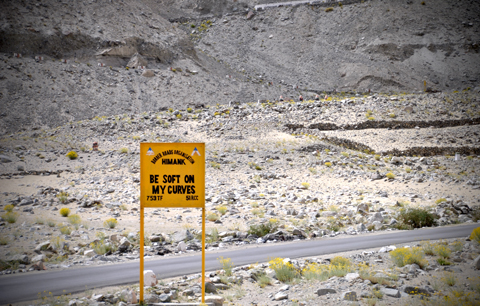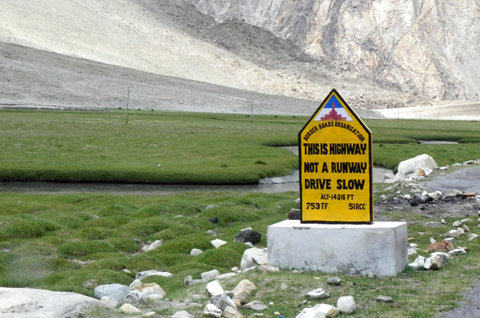Travel: LADAKH—where winds roar and mountains soar!
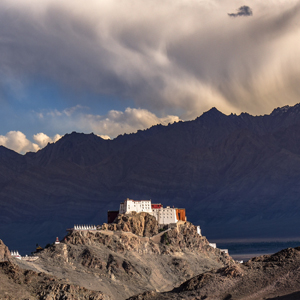
(Left) Sankar Monastery.
Often harsh, always majestic and pristine, the Ladakh region in the Himalayas offers both natural and cultural riches to the intrepid traveler.
The August 5, 2019 decision by the Government of India to abrogate Article 370 of the nation’s Constitution relating to the special status of Jammu & Kashmir (J & K) has once again brought this beautiful but troubled area to the forefront of attention. Significantly, interest in the Ladakh region also peaked thanks to its young Member of Parliament, Jamyang Tsering Namgyal, whose fiery speech in the Lok Sabha grabbed much media attention and internet chatter. Ladakh was a part of the state of Jammu & Kashmir, spanning the Himalayan and Karakoram mountain ranges and the upper Indus River Valley. In August 2019 a reorganization act was passed by the Parliament of India, and from October 31, 2019, Ladakh is now separated from J & K and is designated as a Union Territory without legislature.
|
|
An ancient kingdom for over nine centuries, this high-altitude region in the Western Himalayas has always been attractive to visitors. Ladakh is strongly influenced both by Tibet and the neighboring Muslim region. Linguistically, Ladakhi is very closely related to Tibetan.
A trip to Ladakh takes careful planning. Starting from Delhi, India’s capital, the first thing to decide is whether to undertake a three-day adventurous road trip or an hour and a half air travel to Leh, the largest city and the base for all things Ladakhi. My preference was for the incredible road journey, and it has remained one of my memorable experiences of any trip around the world.
Navigating the morning traffic circus out of Delhi, our route passed through Chandigarh, Mandi, Kulu, and Manali. At Mandi, the glacier-fed Beas River was brimming with joy; the picturesque panoramas offered a perfect changeover from the bustling cities. Higher up, Manali, in sad contrast, was choked with tourists, construction, and unbearable dust.
|
|
| Near Rohtang Pass. |
The beauty of the Himalayas was surreal as I crossed Rohtang Pass at 13,050 feet. We drove past stunning natural formations of sand and rock, rugged mountain views, snow-capped peaks, and barren landscapes— breathtaking! Driving along this spectacular road maintained by the Border Roads Organization is a dream journey that is hard to capture in words. Past Rohtang, suddenly we were isolated, as if in another world. No traffic, no rash overtaking! We drove through a landscape of green hills and steep black peaks. We arrived at Jispa village, a scattering of houses beside a river with mountains towering around—our home for the night was just perfect.
Next morning, crossing Baralacha Pass (16,020 feet), we got to drive through the Himalayas between Indus and Chenab Rivers. Towering mountains in shades of maroon and brown loomed through the mist and cloud, with higher peaks behind. There was not a scrap of vegetation. This landscape intimidates you and equally humbles you. You are a mere speck in its towering presence.
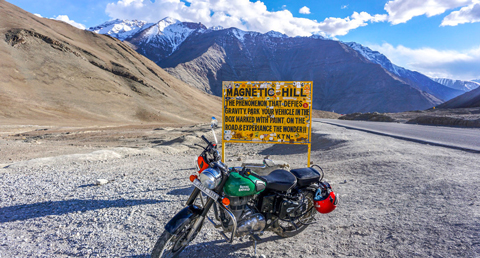
(Left) Magnetic Hill near Leh.
It’s sheer exhilaration, zigzagging through 21 spectacular hairpin bends called Gata loops before reaching Lachung La Pass (16,620 feet). On reaching Taglang La Pass (17,480 feet), the highest elevation on this highway, the thin air forces urbanites to truly feel the difference in breathing and existence. But, from now on it is downhill all the way. The Indus River gushes merrily through green valleys as it weaves its way south from its source in Tibet. The large mountain villages of Upsi and Kuru provide a stunning backdrop and perfect contrast as Leh emerges like a picture postcard at 11,483 feet—my first glimpse of pink mountains, green barley fields, and white houses with brightly painted window frames. I see hay on the roofs and guy lines from which tattered Tibetan Buddhist prayer flags flutter. The journey to Leh is itself an adventure.
|
|
| Ladakh festival dance. |
For the next few days, I am with the local teacher, Rigzin Tsering, who welcomes me with “Julay, julay!” (“Hello, hello!”) as he gives a brief introduction to Leh. “This is a country that venerates its gods, and with a landscape out of a fairy tale, it is like nowhere else on earth,” said Rigzin as we undertook the heritage walk. Tibetan culture is reflected everywhere, in the architecture, shops, restaurants, handicrafts, and cuisine. Food is a delectable combination of momos (savory dumplings), thukpa (noodle soup), tingmo (steamed bread), and kahwa (Kashmiri herb tea). The meal is complemented with butter tea or po cha, locally known as gur gur, and is by far one of the most unique drinks you will ever taste. Boiling tea with baking soda and salt in a samovar (tea urn used in Russia), a large lump of butter is added with yak milk. It’s considered a perfect drink for the harsh environment.
The 17th century Leh Palace is visible from every corner of the city. The nine-story construction of stone, mud bricks, and poplar with gigantic, sloping, buttressed walls and projecting wooden balconies supported on thick beams is perched atop Tsemo Hill. Rigzin took me around and inside a few homes, too, introducing me to the locals. Houses are built with the local building technique of rammed earth on which centuries-old monasteries were built. As I sipped gur gur in the home of Yonten, she said, “Traditional wisdom of building has faded through the years. Young people neglect and don’t maintain their old homes in a traditional way.”
Despite its remoteness, Ladakh has historically been an important trade route. Until the end of the 19th century, mule trains laden with gold, silver, shawls, tea, indigo, coral, muslin, and spices made the 60-day journey from Amritsar (Punjab) in northwest India, across 11 mountain passes through Ladakh to Yarkand in China, where they would at last reach the Silk Road’s southern branch.
Ladakh’s weather conditions are extreme, and the high altitude can pose risks if travelers are not prepared. Temperature swings are dramatic, between day (86° F) and night (50° F) on my trip, between sun and shade, between summer (41° F to 104° F) and winter (-22° F to 68° F), between one day and the next. Such extremity is also seen in the topography. I saw fields and trees and flowers in full bloom and a few hundred meters away, a desert without even the slightest hint of vegetation.
Traveling with Rigzin was entertaining and greatly rewarding. I learnt that Ladakhis strongly disapproved of public displays of anger, disharmony, or discontent. They idealized a peaceful, united, harmonious community, free of conflict and anger. Rigzin’s demeanor and persona were largely reflective of many people I met during my sojourn.
I met Tashi Nurboo, an elderly farmer on the hillock of Shanti Stupa. It is the best place in Leh for watching sunrise or sunset. As I watched the setting sun high up on the mountains, Tashir shared an enlightening thought: “Our cultural practices keep the population from growing to be more than the land can support, and prevent the farm from being divided up and thus becoming unable to support a family.”
|
|
|
Pangong Tso, or Pangong Lake, which served as the backdrop for the dramatic concluding scenes of 3 Idiots, where the heroine (played by Kareena Kapoor in a bright red bridal sari) rides her scooter down a narrow strip of white sand to her estranged lover (Aamir Khan) and is reunited with him in a close embrace against a glorious backdrop of glistening blue water and frosted mountains!. |
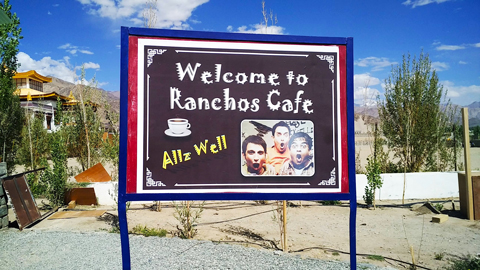
(Left) Rancho’s Café.
Ranchoddas Shamaldas Chanchad, a.k.a. Idiot No. 1, is a name that should ring a bell among Bollywood fans. That was the name of the character played by superstar Aamir Khan in the movie 3 Idiots. The Druk White Lotus School was featured in the movie’s climax scene. It is situated in Shey village, a few kilometers ahead of Leh. The boarding school is nicknamed ‘Rancho’s School’ after the lead character of the movie. Rancho’s Café inside is laid back and cool. For movie fans, it’s an opportunity to take back a memory of a place they loved seeing in the movie. Built on self-sustainable resources and championing green practices to facilitate healthy living for the students, the architecture of the campus is breathtaking.
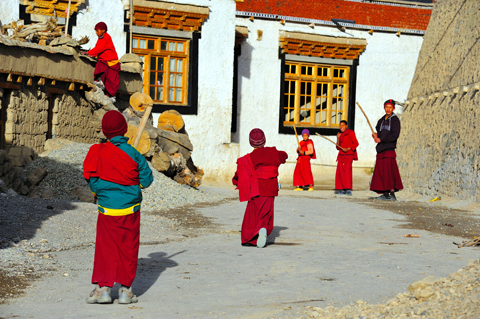
(Left) Shey Monastery, near Leh.
Leh market has a variety of handicraft shops. From imitations to originals, Leh’s shops offer silver jewelry, turquoise, coral stones, handwoven blankets, and more. “Original pashmina shawls are our prime product of export from Leh,” said Ngawang at the manufacturing facility. Pashmina, which means “soft gold” in Kashmiri, is a much sought-after elite fashion wear. I learnt from Ngawang, “The shaggy, wide-horned goats of Ladakh produce pashmina that can fetch as much as $200,000 for a shawl in Paris boutiques.” Pointing to a colorful shawl on the white plastered mud wall he said, “It is called Kani shawl. It has taken two people close to 14 months working 5-7 hours/day for creating that shawl.” I marveled at the intricate and exquisite handwork of the artisans.
Bhaskar Krishnamurthy, an award-winning photojournalist, is the author of Balarama’s Story: An Elephant’s Journey (Peppertree Press), an illustrated children’s book. He co-produced Elephants in the Coffee, an acclaimed documentary. Based in Kansas when he’s not traveling, Krishnamurthy is involved in initiatives that help people in remote corners of India.
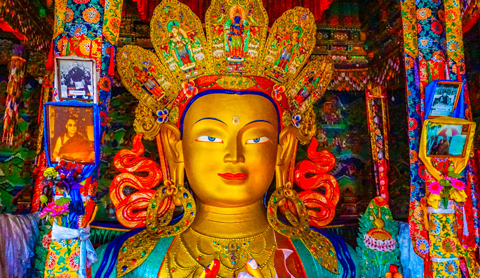
LEH is the starting point for visiting many areas in the region.
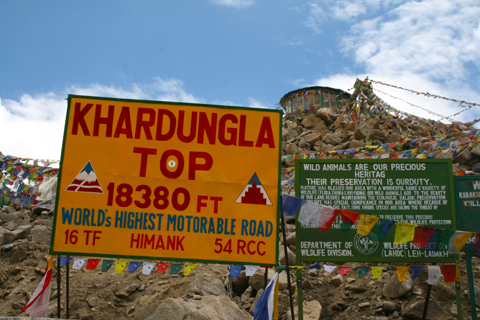
(Left) The Khardung La pass (17,582 ft.) that locals claim is the highest motorable road in the world.
Nubra Valley: To reach this valley, travelers drive over the Khardung La pass (17,582 ft.) that locals claim is the highest motorable road in the world. In Nubra Valley, located at about 13,000 ft. elevation, the silvery dunes stand in relief to the surrounding mountains and small stream flowing through the frozen desert. Here roam pashmina goats and double-humped Bactrian camels, the kind used by merchants traversing the Silk Road—travelers can even relive that ancient tradition on a camelback safari across the dunes.
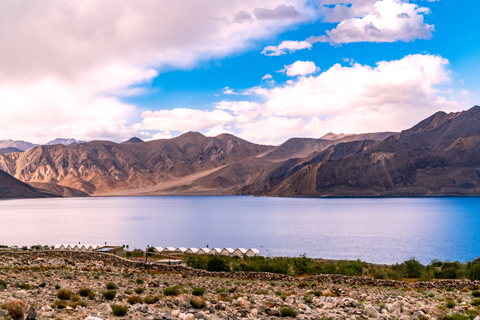
(Left) Another view of Pangong Tso, or Pangong Lake.
Pangong Tso: Dappled by light, this fabulous lake reflects a dazzling mosaic of blues and greens. Snow-dusted mountains loom dreamlike in the distance. This shimmering, turquoise lake served as the backdrop for the dramatic concluding scenes of 3 Idiots, where the heroine (played by Kareena Kapoor in a bright red bridal sari) rides her scooter down a narrow strip of white sand to her estranged lover (Aamir Khan) and is reunited with him in a close embrace against a glorious backdrop of glistening blue water and frosted mountains!
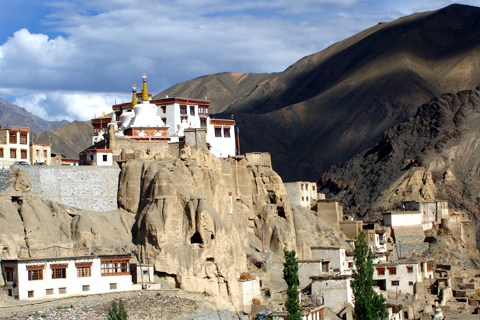
(Left) Lamayuru Gompa.
Lamayuru: Lamayuru is an offbeat but easily accessible village and home to the oldest monasteries in Ladakh. The monastery is famous for stunning chortens (shrine, saint’s tomb, or Buddhist monument) and colorful rocks carved with prayers in intricate detail. Lamayuru is popular for its ‘lunar’ landscape and two annual festivals, Yuru Kabgyat and Hemis Tsechu celebrated in the 2nd and 5th month of the Tibetan lunar calendar. Situated on the route to Srinagar, it is best to visit Lamayuru after a stopover in Kargil, after leaving from Leh. Since the 1970s, yogi Kyunga Rinpoche has run a dedicated yoga retreat here, practicing meditation and spirituality.
Tso Moriri: At 14,767 ft. lies the turquoise Tso Moriri (Lake Moriri or Mountain Lake), in one of the most remote parts of India, nurturing wolves, Tibetan donkeys, and some of Ladakh’s 300-plus species of birds. Surrounded by barren hills with a backdrop of snow-covered mountains, Tso Moriri is a very fine sheet of salty water. The nomadic Changpas of Korzok who tend herds of goats, sheep, and yak inhibit this area. The Changpas live in large, movable family tents or in solid winter-proof brick huts.
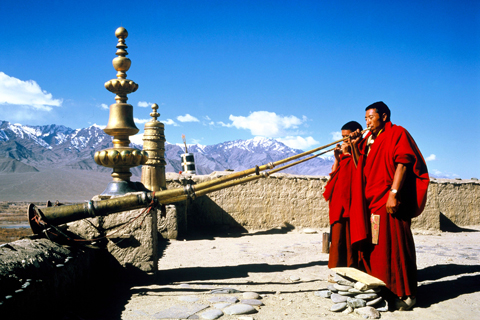
(Left) Thiksey Monastery monks.
Thiksey Monastery: Built in the 15th century, it is one of the largest and most splendid structures of its kind. A stunning 49-ft. statue of Maitreya Buddha resides within. Its temples and subtemples, libraries, and monks’ quarters, dotted with stupas, ramble across the entire hill like a gigantic medieval castle. While the lower buildings are white, the ones at the very top are brick red or yellow ochre.
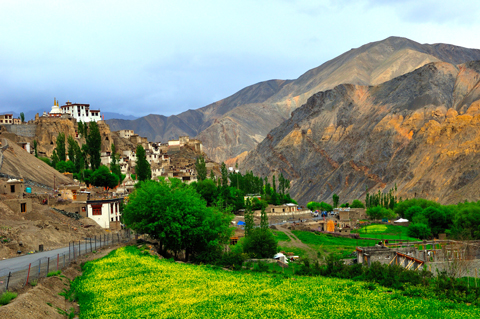
(Left) A Ladakh valley.
Kargil: Located on the western side of Ladakh, Kargil hit international headlines during the Indo-Pakistan hostilities of 1999. The locals feel let down as visitors don’t seem to register that Kargil district is a part of Ladakh, while Leh gets all the attention—and tourism revenue, of course. Less touristy compar-ed to Leh, Kargil is the “Apricot Belt of India” with the fruit being sold by Balti traders. Few visitors are aware of Kargil’s historic legacy as a “melting pot” of various cultures (Kashmiri, Dard-Shina, Balti, Purgi, and Ladakhi) due to its strategic location on the Silk Route.
Is tourism in Ladakh sustainable? That’s still an open question. Tourism will change Ladakh and throw up more complex challenges. Many areas of Ladakh are still off-limits to foreign visitors due to the proximity to the Chinese and Pakistani borders. For those who are fortunate to visit here, Ladakh offers an ancient culture that has stood the test of time, combining wisdom and spirituality. In India’s land of high passes and ferocious winds, ancient customs still rule, and the wilderness is untouched.
|
|
The Border Roads Organization educates and entertains drivers with these quaint signboards:
|
|
|
“Peep peep, don’t sleep”
“Don’t be a Gama [who was overconfident] in the land of Lama”
“Darling I like you, but not so fast”
“Be Mr. Late, than Late Mr.”
|
|
|
“Life is a limited company with unlimited dreams”
“Be gentle on my curves”
“Sorry for Oooh, aahh, ouch … inconvenience regretted”
|
|
“After whisky, driving risky”
“If you are married, divorce speed”
“Drive on horsepower, not rum power”
|
|
Enjoyed reading Khabar magazine? Subscribe to Khabar and get a full digital copy of this Indian-American community magazine.
blog comments powered by Disqus




 (6) FINAL-page-0 top.jpg)
 (6) FINAL-page-3 top.jpg)
 (6) FINAL-page-1 top.jpg)
 (6) FINAL-page-2 top.jpg)
 (6) FINAL-page-5 top.jpg)
